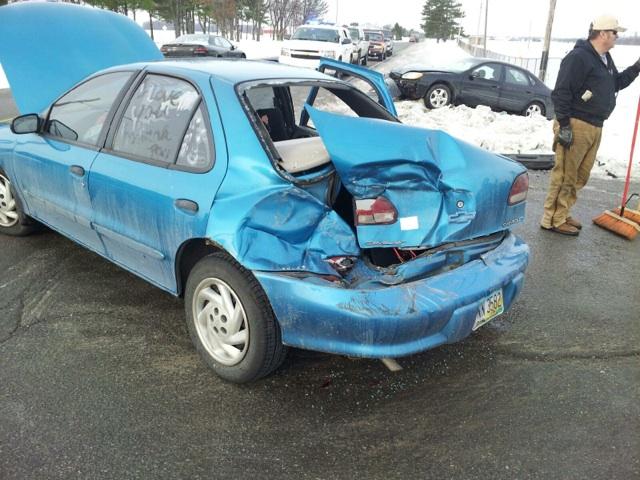By Krystal Smalley
ksmalley@wbcowqel.com
A pair of Wynford mothers is leading the fight to have a safer intersection at Wynford High School. Jaime Langston, Tavia Swain and Wynford Principal Jeff Holbrook met with Crawford County Commissioners and County Engineer Mark Baker Thursday afternoon to discuss ways to make the Holmes-Center Road and County Road 330 intersection safer for students and other travelers.
Langston knows firsthand the perils that can befall a student when he or she makes the drive in to school each day. Her seventeen-year-old daughter Hannah was involved in a wreck at that intersection five weeks ago.
“That’s why I started all of this,” Langston told the commissioners.
Wynford had been on a two-hour delay that day and Hannah, having just turned onto CR 330 from Sinn Road, was stopped at the caution light to turn onto Holmes-Center Road.
“She had just told herself, ‘I should’ve put my sunglasses on’,” Langston recounted.
Another car broadsided her in the passenger door, turning the car 180 degrees and forcing the car to hit a truck stopped on Holmes-Center Road. Hannah’s car was then forced into another spin to face back the way she had come.
“She has to drive this,” Langston said about her daughter driving in from Nevada. “She was lucky she was just bruised.”
“This is sort of an ongoing thing where we keep having a few accidents at the intersection of Holmes-Center and Lincoln Highway over the years and nothing has been done at this point,” said Baker.
Two traffic studies have been done on the intersection over the past nine years but, Baker explained, there wasn’t enough activity to warrant a traffic signal. The Ohio Revised Code does allow for the county commissioners to put in a traffic signal if they want that but that step comes with a lot of liability.
“We just don’t have the volume or the accidents — traffic and accident volume — to justify (adding a traffic signal),” Baker said.
Baker has done some research into the matter, however, and presented three ideas: the commissioners could perform an engineering and traffic study on CR 330 and request a speed limit reduction; they could request a school zone extension by including CR 330 as part of the school zone and, as a result, reduce the speed limit; or the school could construct an access drive near the school’s west property boundary.
For option one, a form would be filled out and sent to the state for review. The state would then determine if the speed can be reduced for that section. For option two, a school zone is determined by the portion of the street that passes the school front. In this case, Holmes-Center Road would qualify but, currently, CR 330 would not. Even if the state grants the extension, if it feels the 20 miles per hour speed limit would create a safety issue, then the speed would revert back to the existing speed limit. For option three, constructing an access drive would fall under the domain of the school.
“People keep bringing that up: that the students are driving. Okay, and that they are inexperienced,” said Swain. “Well, of course they are inexperienced drivers, they just got their license; they’re still learning. But half of the encounters, more than half of the encounters I’ve had at that intersection, have been parents dropping their kids off to school and then rushing out to get to work.”
“At the end of the day, you can look left, look right and I think anyone who has left that intersection has had a chance to be in a bad accident, myself included,” said Holbrook. “We are letting sixteen, seventeen-year-old, eighteen-year-old kids in a car, with limited experience, in an intersection that adults have issues with and that have ten plus years of driving experience. I don’t like those odds.”
Holbrook remembered coming up on Hannah’s car five weeks ago and the sight that greeted him. “First thing I thought was that there’s no one walking away from this. There’s no one walking away from that.”
Holbrook understood that the commissioners were bound by things in this situation. “But in my situation, in these parents’ situation, they’re bound even (more) heavily.”
Langston and Holbrook both agreed that if a traffic signal wasn’t able to go up, they would be happy to just have the speed reduced to 20 miles per hour.
“I would rather somebody hit my kid at 30, not following the 20 mile per hour, than 55 or 60,” said a passionate Langston.
Holbrook said three students have been involved in accidents at the Holmes-Center Road and CR 330 intersection this year alone. He didn’t factor in the six-car crash that occurred there last Friday, where at least two students were involved. Within the last two years, the Wynford principal believed he had witnessed 10 crashes there.
Langston and Swain liked the idea of putting in an access drive and suggested getting local families and companies involved to offset the cost.
‘If there’s something that can improve the safety of that intersection, I say full steam ahead,” Holbrook said. He will be taking the suggestions before the Wynford Board of Education.
“At the end of the day, what price tag do you put on a kid’s life?” asked Holbrook.
Baker will be researching the issue further and plans on contacting someone at the Ohio Department of Transportation or at the state for more information.


